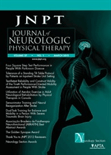
Journal of Neurologic Physical Therapy
Scope & Guideline
Empowering Practitioners in Neurologic Physical Therapy
Introduction
Aims and Scopes
- Neurological Rehabilitation Techniques:
The journal emphasizes research on various rehabilitation techniques tailored for neurological disorders, including stroke, Parkinson's disease, and multiple sclerosis. - Assessment and Measurement Tools:
There is a strong focus on developing and validating assessment tools that measure functional outcomes and the effectiveness of rehabilitation interventions. - Telehealth and Remote Rehabilitation:
The journal explores the integration of telehealth in neurological physical therapy, particularly in response to the COVID-19 pandemic, highlighting innovative approaches to patient care. - Interdisciplinary Approaches:
Research often incorporates interdisciplinary methodologies, combining insights from neurology, psychology, and rehabilitation science to enhance therapeutic practices. - Patient-Centered Care:
The focus on patient perspectives and subjective experiences is evident, emphasizing the importance of tailoring interventions to individual needs and contexts.
Trending and Emerging
- Vestibular Rehabilitation:
Research on vestibular rehabilitation has gained momentum, especially concerning its application in various neurological conditions and the impact of recent global health challenges like COVID-19. - Robotic and Technological Interventions:
The use of robotic devices and technology-enhanced rehabilitation methods is emerging, demonstrating advancements in patient mobility and recovery through innovative tools. - Physical Activity and Exercise Interventions:
There is a growing emphasis on the role of physical activity and structured exercise programs, particularly in improving outcomes for individuals with chronic neurological conditions. - Telehealth and Virtual Rehabilitation Programs:
The COVID-19 pandemic has accelerated interest in telehealth, with numerous studies exploring the feasibility and effectiveness of virtual rehabilitation programs. - Cognitive-Motor Interactions:
Research focusing on the interplay between cognitive functions and motor performance is on the rise, underscoring the importance of addressing both aspects during rehabilitation.
Declining or Waning
- Traditional In-Person Rehabilitation Models:
As telehealth and remote interventions gain traction, traditional in-person rehabilitation models are receiving less focus, indicating a shift towards more flexible care delivery methods. - Basic Mechanisms of Neurological Disorders:
Research concentrating solely on the biological mechanisms of neurological disorders, without direct implications for therapy or rehabilitation, appears to be diminishing. - Single-Domain Interventions:
There seems to be a decrease in studies focusing on isolated therapeutic approaches, as there is a growing trend toward multifaceted interventions that address multiple aspects of rehabilitation. - Longitudinal Studies of Specific Conditions:
While longitudinal studies are valuable, there has been a decline in studies solely focusing on long-term outcomes for specific neurological conditions without integrating broader rehabilitation insights.
Similar Journals
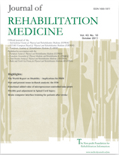
JOURNAL OF REHABILITATION MEDICINE
Unlocking Potential: Pioneering Research in Rehabilitation MedicineJOURNAL OF REHABILITATION MEDICINE, published by the FOUNDATION REHABILITATION INFORMATION in Sweden, stands as a leading platform for the dissemination of groundbreaking research in the field of rehabilitation. With an impact factor that places it in the Q1 category for Physical Therapy and Rehabilitation and a noteworthy Q2 ranking in Sports Science and Medicine (miscellaneous), this journal serves as an essential resource for researchers, clinicians, and students dedicated to improving patient care and rehabilitation outcomes. As an Open Access publication since 2001, it ensures that knowledge is widely accessible, promoting collaborative efforts across the global rehabilitation community. Aiming to bridge the gap between research and clinical practice, the journal covers a comprehensive range of topics, providing a vital forum for innovative studies that advance the understanding and effectiveness of rehabilitation therapies. As it approaches its convergence into 2024, the JOURNAL OF REHABILITATION MEDICINE continues to be a cornerstone for all those committed to advancing rehabilitation sciences.
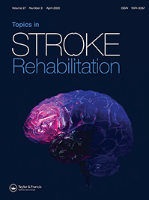
Topics in Stroke Rehabilitation
Empowering recovery through innovative research.Topics in Stroke Rehabilitation, published by Taylor & Francis Ltd, stands as a premier academic journal offering cutting-edge research and insights in the fields of rehabilitation, neurology, and community care. With an impressive impact factor reflecting its strong scholarly influence, this journal not only maintains a distinguished Q1 ranking in Community and Home Care and Rehabilitation but is also recognized in the Q2 category for Clinical Neurology, showcasing its relevance across multiple disciplines. Covering a comprehensive range of topics from neurorehabilitation techniques to patient-centered care strategies, Topics in Stroke Rehabilitation serves as an essential resource for researchers, healthcare professionals, and students dedicated to enhancing the quality of life for individuals recovering from stroke. With an accessible archive dating back to 1996 and continuous publication through 2024, this journal invites collaboration and discourse, fostering advancements in both theoretical knowledge and practical applications within the realm of stroke rehabilitation.
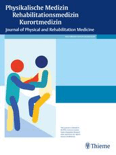
PHYSIKALISCHE MEDIZIN REHABILITATIONSMEDIZIN KURORTMEDIZIN
Redefining Rehabilitation: Bridging Theory and PracticePHYSIKALISCHE MEDIZIN REHABILITATIONSMEDIZIN KURORTMEDIZIN, published by GEORG THIEME VERLAG KG, is a prominent journal dedicated to the fields of physical medicine, rehabilitation, and resort medicine. With its ISSN of 0940-6689 and E-ISSN 1439-085X, this journal has been at the forefront of disseminating essential research and innovative practices since its inception. Operating from Germany, it offers a crucial platform for professionals, researchers, and students engaged in exploring the latest advancements in rehabilitation methodologies and therapeutic practices. Although it currently holds a Q4 ranking in several categories including Physical Therapy and Rehabilitation, the journal is committed to enhancing its impact and visibility within the academic community. The journal publishes research, reviews, and clinical studies aimed at improving patient outcomes and advancing the science of rehabilitation. Subscribers can expect high-quality content that addresses both theoretical and practical aspects of rehabilitation medicine, ultimately contributing significantly to ongoing discussions and developments in the field.
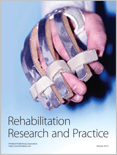
Rehabilitation Research and Practice
Pioneering Insights in Rehabilitation Science.Rehabilitation Research and Practice is a distinguished open-access journal published by HINDAWI LTD, dedicated to advancing knowledge in the fields of rehabilitation, physical therapy, and sports therapy. With its ISSN 2090-2867 and E-ISSN 2090-2875, the journal has been a pivotal resource for researchers and practitioners since its inception in 2010. Based in Egypt and reaching an international audience, the journal encapsulates cutting-edge research and evidence-based practices that significantly contribute to patient care and rehabilitation strategies. Notably, it holds a reputable position in the Scopus rankings—42nd out of 161 in Medicine Rehabilitation and 74th out of 247 in Health Professions. The journal enjoys a Q2 status in the 2023 category quartiles, reflecting its influence and quality within the academic community. The journal's commitment to an open-access format not only enhances its visibility and accessibility but also fosters collaboration among professionals, making it an indispensable resource for anyone engaged in rehabilitation research and practice.
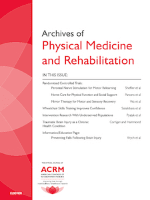
ARCHIVES OF PHYSICAL MEDICINE AND REHABILITATION
Shaping the Future of Rehabilitation with Every PublicationArchives of Physical Medicine and Rehabilitation, published by W B Saunders Co-Elsevier Inc., is a premier academic journal dedicated to the fields of physical therapy, sports therapy, and rehabilitation. Since its inception in 1945, it has evolved to provide a platform for groundbreaking research and insightful discourse that shapes clinical practice and enhances patient outcomes. With a notable impact factor and ranking in the top quartiles of its respective categories, this journal consistently showcases the most innovative studies, systematic reviews, and evidence-based practices that drive forward the understanding of rehabilitation medicine. As a vital resource for researchers, healthcare professionals, and students alike, it contributes significantly to the advancement of knowledge in rehabilitation sciences. With an aim to bridge the gap between research and practice, the journal invites contributions from all disciplines related to physical medicine and rehabilitation, fostering a collaborative environment that promotes the dissemination of impactful findings.
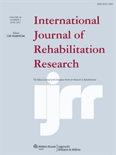
INTERNATIONAL JOURNAL OF REHABILITATION RESEARCH
Championing evidence-based practices in rehabilitation and therapy.INTERNATIONAL JOURNAL OF REHABILITATION RESEARCH, published by Lippincott Williams & Wilkins, stands as a vital resource within the fields of rehabilitation and physical therapy. With an ISSN of 0342-5282 and an E-ISSN of 1473-5660, this peer-reviewed journal has been disseminating groundbreaking research since its inception in 1978. As of 2023, it holds commendable rankings with a Q3 in Medicine (miscellaneous) and Q2 in both Physical Therapy, Sports Therapy, and Rehabilitation, as well as Rehabilitation, highlighting its significant contribution to these disciplines. The journal seeks to advance knowledge and practice in rehabilitation by serving as a platform for high-quality research, clinical studies, and theoretical discussions. It is particularly valuable for researchers, healthcare professionals, and students aiming to stay at the forefront of rehabilitation science and practice. Although not designated as open access, the journal remains accessible through various academic databases, ensuring that its content reaches a broad audience committed to improving rehabilitation therapies and outcomes.
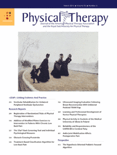
Physical Therapy
Transforming Patient Outcomes Through Rigorous Research.Physical Therapy is a leading journal in the field of rehabilitation sciences, published by Oxford University Press Inc. Renowned for its rigorous peer-reviewed articles, the journal covers a broad range of topics within physical therapy, sports therapy, and rehabilitation, making it a vital resource for researchers, clinicians, and students. With an impressive impact factor and ranking—Q1 in its category (Physical Therapy, Sports Therapy and Rehabilitation) and ranked 19 out of 247 in Scopus—this journal stands at the forefront of advancing knowledge and practice in this vital health discipline. The journal has maintained its dedication to publishing original research, systematic reviews, and clinical studies since its inception in 1964, contributing significantly to evidence-based practices in the field. With a commitment to enhancing patient care and fostering professional development, Physical Therapy remains an essential platform for the dissemination of cutting-edge research and innovative therapeutic techniques.
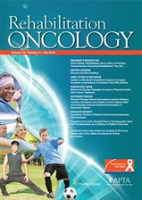
Rehabilitation Oncology
Illuminating Pathways to Recovery for Cancer SurvivorsRehabilitation Oncology, published by Lippincott Williams & Wilkins, is an essential academic journal dedicated to the interdisciplinary field of cancer rehabilitation. Since its inception in 2008, it has provided a platform for illuminating research, clinical practices, and innovative therapies aimed at improving the quality of life for cancer survivors. With an ISSN of 2168-3808 and an E-ISSN of 2381-2427, the journal covers a wide spectrum of topics, making significant contributions across various categories including Oncology, Rehabilitation, and Physical Therapy. Although currently not Open Access, the journal has garnered a notable 2023 Impact Factor status, placing it in the Q3 quadrant across multiple relevant disciplines as per the latest Scopus rankings. This reflects its growing influence in the rehabilitation community and offers vital insights for practitioners and researchers seeking to advance their understanding of patient care post-cancer treatment. With its focus on bridging the gap between research and real-world application, Rehabilitation Oncology serves as a vital resource for healthcare professionals committed to enhancing recovery outcomes in their patients.

Journal of Pediatric Rehabilitation Medicine
Unlocking Potential: Pioneering Pediatric Rehabilitation InsightsJournal of Pediatric Rehabilitation Medicine is a leading academic platform published by IOS PRESS, dedicated to advancing knowledge in the fields of pediatrics, rehabilitation, and physical therapy. With an ISSN of 1874-5393 and an E-ISSN of 1875-8894, this journal has carved a niche within the biomedical community, focusing on therapeutic innovations and evidence-based practices in pediatric rehabilitation. Recognized for its scholarly contributions, it holds a prestigious Q3 ranking in Pediatrics and Q2 rankings in both Physical Therapy and Rehabilitation categories, indicating its impact and relevance in the respective fields. Operating out of the Netherlands, the journal provides a comprehensive open access model that ensures that research is easily accessible to professionals, students, and researchers alike. With converged years spanning from 2007 to 2024, the journal continues to be an essential resource for those dedicated to enhancing the quality of life for children with disabilities and rehabilitation needs, fostering collaboration between clinicians and researchers through high-quality research dissemination.

International Journal of Sports Physical Therapy
Advancing sports therapy through cutting-edge research.Welcome to the International Journal of Sports Physical Therapy, a premier platform dedicated to advancing the field of sports therapy and rehabilitation. Published by the NORTH AMER SPORTS MEDICINE INST-NASMI, this open access journal has been vital in disseminating state-of-the-art research since its inception in 2011. With an ISSN of 2159-2896, it boasts a commendable standing within the academic community, achieving a Q2 ranking in 2023 across multiple categories, including Orthopedics and Sports Medicine, Physical Therapy, and Rehabilitation. Spanning diverse topics relevant to sports physical therapy, this journal serves as an invaluable resource for researchers, clinicians, and students alike, promoting best practices and innovative techniques in the field. By maintaining a commitment to high-quality peer-reviewed content, it not only contributes significantly to the existing body of knowledge but also fosters collaboration among professionals seeking to enhance patient care and rehabilitation outcomes.